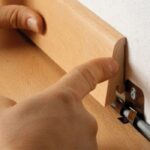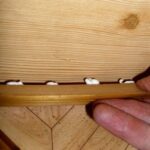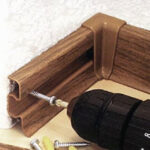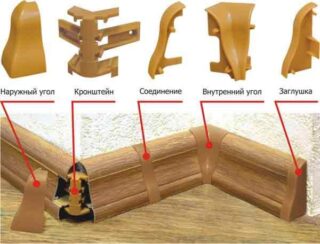Fastening the skirting board to the floor is the final stage in the repair or replacement of the coating. Since this element of the interior is located in one of the most prominent places in the room, special attention should be paid to its installation. You need to fix the plinth to the floor firmly enough so as not to move or tear it off during cleaning or accidental contact with furniture or the feet of residents.
Varieties of plastic skirting boards for the floor
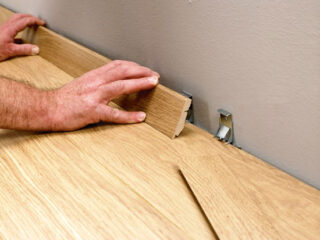
The decision to fix skirting boards to the floor is often made. The reason lies in the properties of the materials. If the walls are made of concrete, foam blocks, drywall, or brick, it is quite problematic to attach profiles to them. It is much easier to fix them to a pliable wooden base in the form of parquet, laminate and solid planks.
Manufacturers produce skirting boards with floor mounting of the following design:
- Corpulent. Manufactured in one-piece design, some models have internal cavities for cable routing.
- Cable channels. They are a collapsible structure, where the mounting shelf is covered with a decorative strip. There are two communication channels.
- Planks. The base is wrapped in paper or foil, fastening to the base is carried out using shaped brackets.
On sale are products made of wood, PVC and MDF. The most popular products are made from polymeric materials. It is distinguished by such qualities as strength, resistance to moisture, environmental friendliness and durability. It is so easy to fix the plastic skirting board to the floor that even a housewife and a child can cope with it. Do-it-yourself installation of a floor plinth made of MDF is much more difficult. The material is fragile and requires skill and care in handling.
Methods for attaching the plinth to the floor
Modern profiles, regardless of the material of manufacture, are distinguished by functionality, practicality and versatility. They can be installed in several ways:
- For hardware. First, a through hole is made in the rail, then a nail or self-tapping screw is inserted into it, after which they are fixed to the base with a hammer or screwdriver. If you need to attach the plinth to concrete, you first drill, then a plastic dowel is inserted into the hole.
- Liquid Nails. This is the easiest and fastest way to install any type of profile. The adhesive is viscous enough to hold the product even under strong mechanical stress. The downside is that the decision to glue the strips is fraught with the complexity of their dismantling. It is almost impossible to do this without damaging the skirting boards.
- Clips and straps. The hidden installation method involves attaching only supporting structures to the base, into which the slats are then inserted. First, the clips or strips are screwed to the floor, and then the profile is already attached to them by lightly pressing the hand.
When buying a skirting board, you should ask the seller about the features of its fastening, since in some cases one or another method may not be applicable to certain repair conditions.
Calculation of material consumption
Calculating the need for the material will not pose any particular problems. It is necessary to measure the perimeter of the room, subtract the dimensions of the doorways from it, divide the result by the length of one rail and round the resulting number up. The number of trimmings must be taken into account.It is better to take one more profile than to assemble one side of the room from several fragments.
It makes no sense to close the corner in those places where cabinet or upholstered furniture will stand right next to the wall. It is enough to close only open areas.
There is one more little thing that should not be forgotten - accessories. In accordance with the layout of the room, internal and external corners, docking elements, one right and one left plug for each door will be required.
Required tools and materials
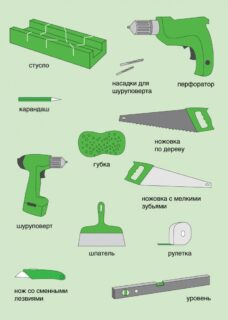
To carry out the installation of the plinth, a set of tools is enough that are in the pantry of any home craftsman:
- puncher, screwdriver, electric drill;
- a hammer;
- hacksaw for metal;
- awl;
- core;
- miter box;
- stationery knife;
- marker;
- plastic dowels, self-tapping screws:
- protective goggles and gloves.
Since the work will be accompanied by the formation of dust, sawdust and scraps, you need to prepare a broom, scoop, a bucket of water and a rag.
Fastening a plastic skirting board to the floor with your own hands
Correctly fasten the floor plastic skirting board to the concrete base in the following sequence:
- Draw up a profile arrangement diagram. Docking is best done where it will subsequently be covered with furniture. It is advisable to start the installation from the door or from the corner, first placing whole lamellas.
- Carry out measurements, taking into account the fact that the cavity of the corners is 5 mm, and the joints are 2 mm. Cut the slats using a miter box and a hacksaw. Remove burrs with your fingers or cut with a knife.
- Make a hole in the skirting boards with a thin drill or awl. The holes are made at a distance of 5 cm from the edges with an interval of 40-50 cm, if the wall is strongly curved, it is possible less often.
- Transfer the holes from the panel to the floor using a marker. Drill holes, clean them of dust and crumbs, insert dowels inside. If some of the plastic remains above the surface, cut it flush. Sweep the floor, wipe it with a wet rag so that dust does not spread throughout the apartment.
- Remove the decorative strip, connect the profile to the corner, insert the cable (if any), screw the self-tapping screws. Return the bar to its place.
- Measure, saw off from the whole rail, as much as needed to the corner. Install the docking element, angle, try on, adjust.
In the future, similar actions are carried out with drilling and screwing. With the correct calculations, the skirting board will lie flat, without cracks and distortions.

